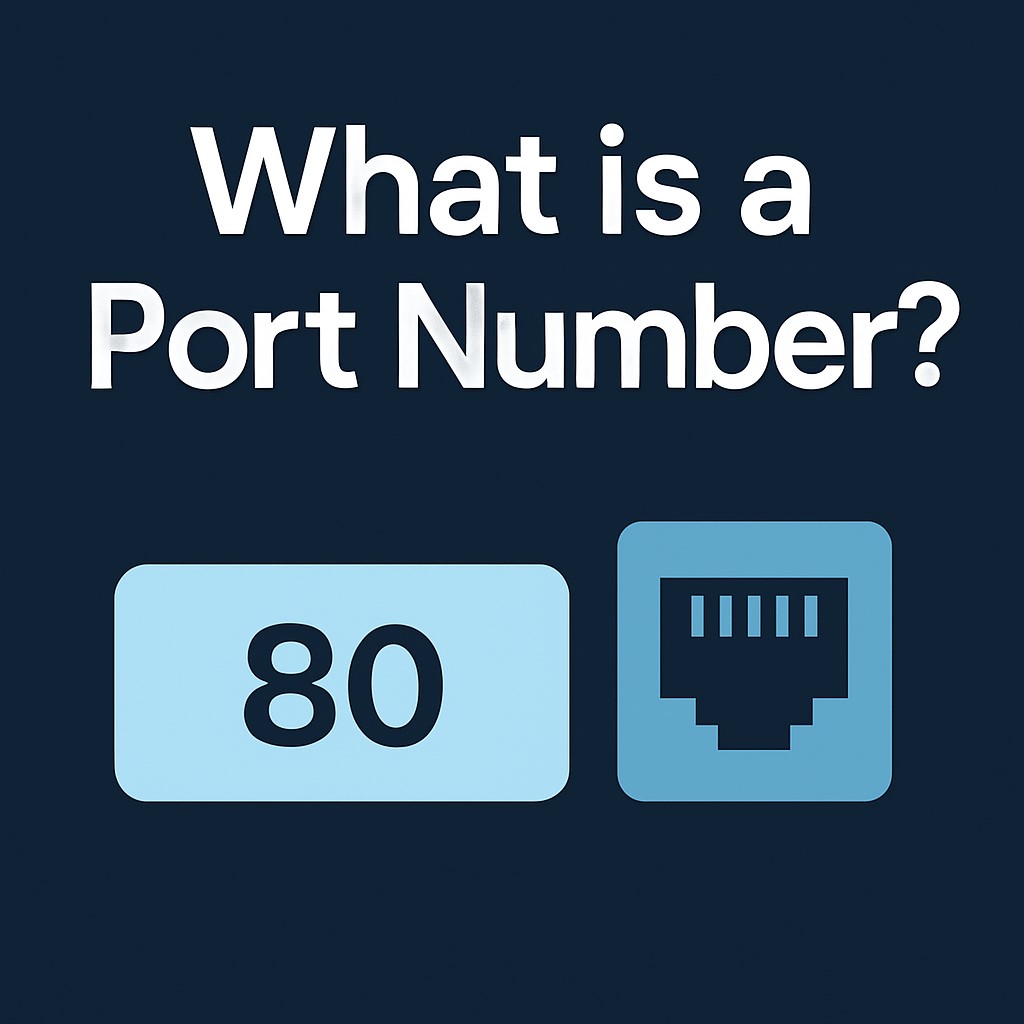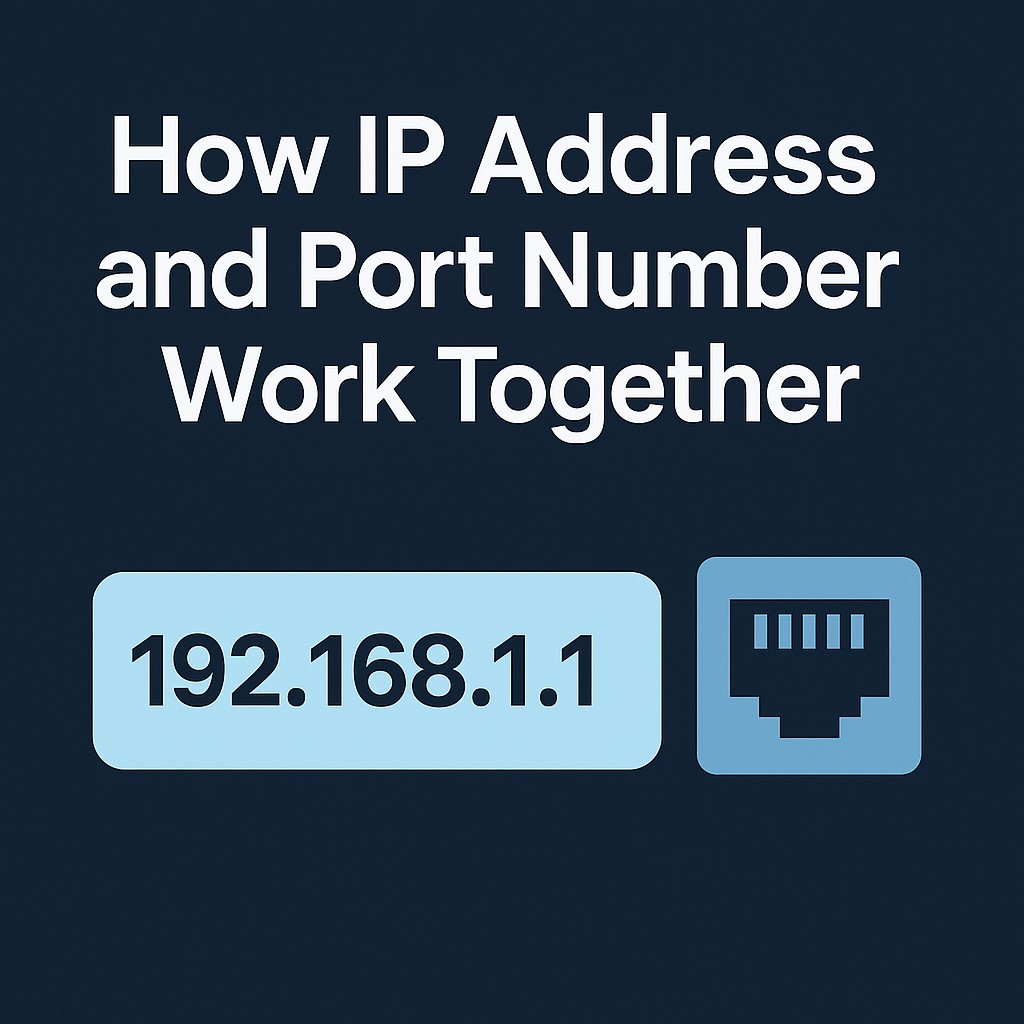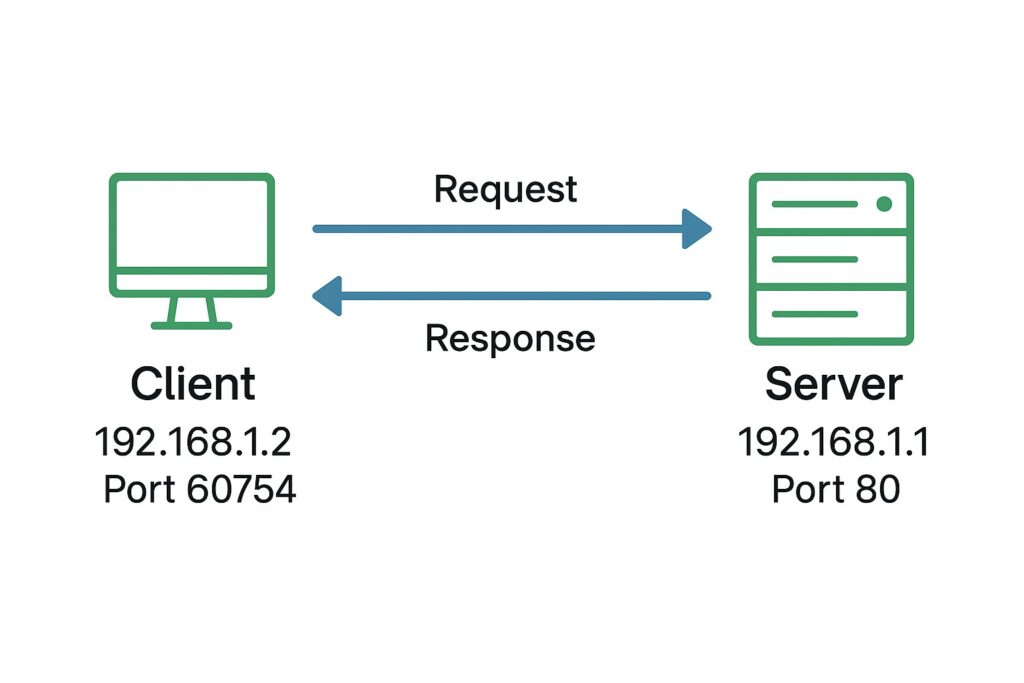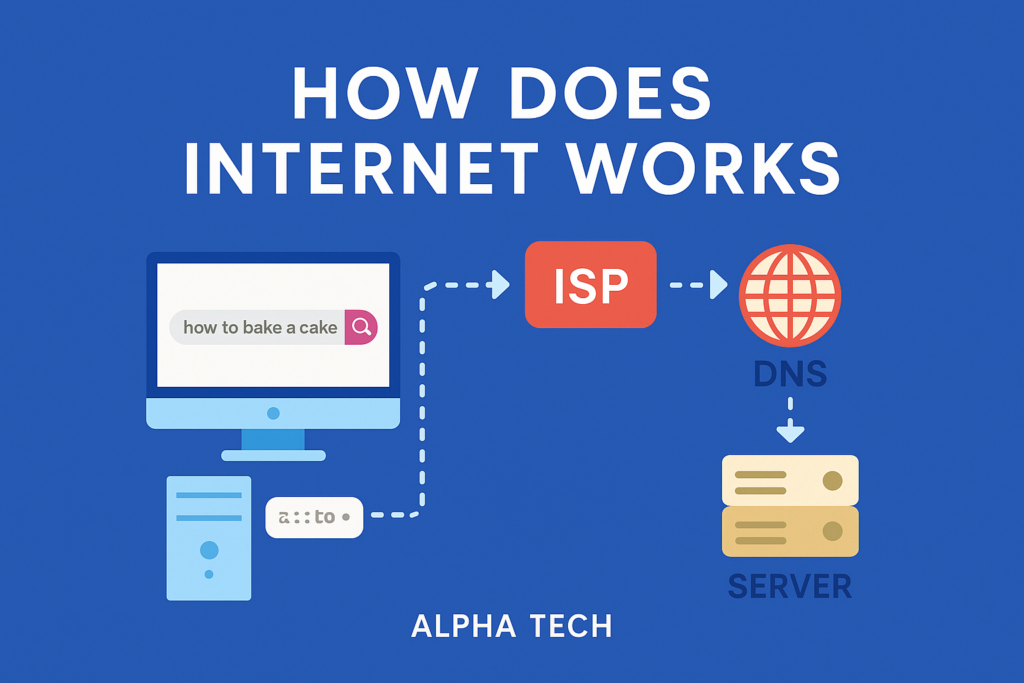- Introduction to IP Addresses and Port Numbers
- What is an IP address?
- What is a Port Number?
- How IP Address and Port Number Work Together?
- Difference Between IP Address and Port Number
- Tools to Find Your IP Address and Port Usage
- Importance of IP Addresses and Ports in Cybersecurity
- Frequently Asked Questions
Introduction to IP Addresses and Port Numbers
The internet might feel like magic, but behind the scenes, it’s all about communication between devices — and for that communication to happen, two key things are needed: IP addresses and port number.
=>Why Should Students Learn About This?
If you’re a student in computer science, IT, or even someone just curious about how the internet works — understanding IP addresses and port numbers is a must.
Every time you visit a website, stream a video, or send a message online, your device connects to another device somewhere in the world. This connection happens using an IP address, which acts like a digital home address, and a port number, which acts like a specific room number in that house.
Learning these basics lays the foundation for topics like:
- Computer networking
- Ethical hacking
- Cybersecurity
- Web and app development
- Cloud computing
=> Real-World Example: How Devices Communicate
Imagine you’re sending a letter to a friend who lives in a big apartment building.
- The building address helps the post office find the right building (this is like an IP address).
- The apartment number tells them which exact flat the letter should go to (this is like a port number).
Now apply this to the internet:
- The IP address helps data reach the correct device (your phone, computer, etc.).
- The port number makes sure the data goes to the right app or service on that device (like your browser, YouTube, or email app).
Together, IP addresses and port numbers make it possible for billions of devices and services to communicate smoothly across the internet.
IP addresses tell data where to go, and port numbers tell it what it’s for once it gets there.
want to learn more about Computer network click here
What is an IP address?

Definition and Basic Concept
An IP address (Internet Protocol Address) is like the unique phone number of a device on a network, such as the internet or a local network. Just like how every phone in the world needs a unique number to make calls, every device connected to a network needs an IP address to communicate with other devices.
Think of it as your device’s identity card that allows other devices to find and interact with it. Whether it’s a website, game server, or another computer, they use IP addresses to know where to send information. Without an IP address, devices wouldn’t be able to recognize each other or send data.
Types of IP Addresses
There are a few types of IP addresses, and they work in different ways. Let’s take a closer look:
- IPv4 vs IPv6
- IPv4 (Internet Protocol version 4): This is the older version, and it uses a 32-bit address (something like 192.168.1.1). It’s still the most common type but has a limited number of addresses, so we’re running out.
- IPv6 (Internet Protocol version 6): This is the newer version, which uses a 128-bit address (something like 2001:0db8:85a3:0000:0000:8a2e:0370:7334). IPv6 provides a much larger pool of addresses and ensures we won’t run out of unique IPs.
- Private vs Public IPs
- Private IPs: These are used within local networks (like in your home or office). Devices in your house, like your phone, laptop, and smart TV, each have a private IP, but these addresses can’t be reached from the outside world.
- Public IPs: These are assigned to your network by your internet service provider (ISP). They can be accessed from anywhere in the world. This is what people see when they connect to websites.
- Static vs Dynamic IPs
- Static IPs: These are permanent addresses that don’t change. They’re often used by websites, servers, or devices that need a constant connection.
- Dynamic IPs: These addresses change over time and are typically assigned by ISPs to home networks. Your IP address can change every time you connect to the internet.
How IP Addresses are Assigned?
IP addresses are assigned by organizations called Internet Service Providers (ISPs). For instance, when you connect your computer or phone to the internet, your ISP gives you a temporary or permanent IP address to access websites and other online services.
Just like how each phone number is assigned by telecom companies, IP addresses are managed by global organizations to ensure each one is unique.
Example of an IP Address in Use
Let’s say you want to visit a website like www.example.com. When you type the website’s name into your browser, your device sends a request to the internet asking for the IP address of www.example.com. Once the address is found, your browser connects to that IP and loads the website.
So, an IP address is not just a bunch of numbers; it’s what helps you find and connect to things on the internet, whether it’s a website, game, or any other service.
What is a Port Number?

Definition and Function
Imagine that your IP address is the house address of a device, but to send information to the right place inside that house, you need to know the door or room number. This is where port numbers come in!
A port number is like the specific door or room number inside a device (like your computer or server) that helps data know where to go. While the IP address identifies the device, the port number tells the device which program or service should handle the incoming or outgoing data.
For example, if you want to visit a website, your device uses port number 80 (the default port for HTTP) to get the website’s information. If you’re sending an email, it uses a different port number, like 25 (for SMTP, the email protocol).
Why Do We Need Port Numbers?
Port numbers are necessary because a single device can run many different services at the same time. For instance, your computer may be browsing a website, downloading a file, and sending an email all at once. Without port numbers, it would be impossible to tell which data belongs to which service. Port numbers help organize and direct the data to the right service.
Common Port Numbers and Their Uses
Here are some common port numbers that you might come across:
- Port 80 (HTTP): This is the standard port for web traffic. If you’re visiting a website using HTTP, your device connects to port 80 on the website’s server.
- Port 443 (HTTPS): This is used for secure web traffic. Websites that use encryption (HTTPS) run on port 443.
- Port 21 (FTP): Used for transferring files between devices.
- Port 25 (SMTP): This port is used for sending emails.
- Port 110 (POP3): Used by email clients to receive emails.
- Port 53 (DNS): This port helps translate website names (like google.com) into IP addresses.
Each of these port numbers is like a unique key that tells the device what kind of data or service to connect to.
Range of Port Numbers (Well-known, Registered, Dynamic)
Port numbers are divided into different ranges, each with its own purpose:
- Well-known Ports (0-1023): These are reserved for common, widely-used services like HTTP (port 80), HTTPS (port 443), and FTP (port 21).
- Registered Ports (1024-49151): These are assigned to software applications and services that are less common than well-known services.
- Dynamic or Private Ports (49152-65535): These are temporary ports assigned for private or temporary use by applications that need them.
Simple Analogy
Think of your IP address like a building address, and the port number as a specific door inside the building. When you send data to an IP address, the port number helps make sure it goes to the correct service or application. Without port numbers, the device wouldn’t know what to do with the data.
How IP Address and Port Number Work Together?

Concept of Socket (IP + Port)
When your device needs to communicate with another device over the internet, it uses a combination of two things: the IP address and the port number. Together, these two pieces of information form something called a socket.
Think of the IP address as the house address and the port number as the specific door of that house. The socket is the full address where your device sends or receives data. For example:
- IP address: 192.168.1.1 (the building address)
- Port number: 80 (the door inside the building, used for web traffic)
When you visit a website, your computer sends a request to the socket (IP address + port number) of the web server. The server then sends back the website’s data through the same socket. This way, the server knows exactly which service (e.g., HTTP, HTTPS) to respond to.
Real-Life Example: Web Browsing or Gaming
Let’s break it down with two real-life examples:
- Web Browsing:
When you type www.example.com into your browser, your device sends a request to the server’s IP address (e.g., 192.168.1.1). Along with the IP, it includes port 80 (the door for HTTP). The server receives the request and sends back the website’s content, which your browser shows on your screen. - Online Gaming:
In an online multiplayer game, your computer connects to the game server using the server’s IP address (e.g., 192.168.100.25). The game uses a specific port number, like 27015 (common for games like Counter-Strike). The game data (like your movements, actions, etc.) is sent through this port, allowing the server and your game client to communicate in real-time.
In both examples, the combination of the IP address (location) and the port number (specific service or app) ensures that the data goes to the right place.
Diagram/Flow of Data Transfer

Here’s how the data flows between devices:
- Your device sends a request to the server’s IP address and port number.
- The server receives the request at the specified port.
- The server processes the request (like loading a website or handling game data).
- The server sends the response back to your device through the same socket (IP + Port).
This process happens in milliseconds, allowing us to access websites, play games, or use any online service almost instantly.
Difference Between IP Address and Port Number
Although IP addresses and port numbers often work together, they serve very different purposes in networking. Let’s break it down in a way that’s super easy to understand.
Comparison Table
| Feature | IP Address | Port Number |
|---|---|---|
| Purpose | Identifies a device on a network | Identifies a specific service or app on that device |
| Example | 192.168.1.5 | 80, 443, 25, etc. |
| Acts Like | A house address | A door number inside the house |
| Is It Unique? | Yes, must be unique in a network | Can be repeated on different devices |
| Assigned By | ISP, router, or manually | Automatically by OS or app, or manually |
| Used In | Every device connected to a network | Every service running on that device |
| Combines With | Port number to form a socket | IP address to form a socket |
=>Simple Analogy: House Address vs. Door Number
Imagine you’re sending a letter to a big apartment building:
- IP Address = Building Address – It tells the postman which building to go to.
- Port Number = Door Number – It tells him which specific flat in the building to deliver the letter to.
Similarly, when data is sent over the internet:
- The IP address finds the device.
- The port number finds the correct app or service on that device.
So, together they ensure that data reaches the right device and the right place on that device!
Tools to Find Your IP Address and Port Usage
Knowing how to check your IP address and port activity is super useful — whether you’re setting up a network, troubleshooting internet issues, or just learning how things work behind the scenes. Let’s see how to find this information on different devices.
For Windows
To Find Your IP Address
- Press
Windows + R, typecmd, and hit Enter. - In the Command Prompt, type: ipconfig
- Look for IPv4 Address — that’s your local/private IP address.
To Check Port Usage
- In the Command Prompt, type: netstat -a. This will show all active connections and listening ports
- For more details: type : netstat -ab. (Note: You might need to run Command Prompt as administrator.)
For MacOS
To Find Your IP Address
Click on the Apple menu → System Settings → Network.
Select your current network (Wi-Fi or Ethernet).
You’ll see your IP address listed there.
To Check Port Usage
- Open Terminal.
- Type : netstat -an
For Android
To Find Your IP Address
- Go to Settings → About Phone → Status → IP address.
To check port Usage
You’ll need third-party apps like:
- Netstat Plus
- Fing – Network Tools These can show you port activity and connected devices on your network.
Online Tools & Web Services
If you just want to know your public IP address, open any browser and visit:
For port scanning or checking open ports:
These tools are super helpful for checking if certain ports (like for games or servers) are open and reachable from the internet.
Summary
| Platform | Tool/Command | Purpose |
|---|---|---|
| Windows | ipconfig, netstat | View IP and port usage |
| macOS | Network settings, Terminal | View IP and active ports |
| Android | System settings, apps | View local IP and network tools |
| Online | Websites like ipinfo.io | Check public IP and port status |
Importance of IP Addresses and Ports in Cybersecurity
When we talk about cybersecurity, IP addresses and port numbers play a major role in protecting devices, networks, and data from attacks. Let’s break it down in a way that’s super simple to understand.
Firewalls and Port Blocking
A firewall is like a security guard for your device or network. It checks all incoming and outgoing data and decides whether to allow or block it based on rules.
- If a port is open, it means data can go in and out through it.
- If a port is blocked/closed, it means no data can pass — this is useful if you don’t want a service to be accessed.
=>Why it matters?
Hackers often scan open ports to find weak points. By blocking unused or suspicious ports, firewalls prevent unauthorized access to your device or network.
IP Spoofing and Protection
IP Spoofing is when an attacker pretends to be someone else by using a fake IP address. It’s like faking a caller ID on a phone call.
- Attackers use spoofed IPs to bypass security systems, perform DDoS attacks, or trick users into trusting them.
=> How to stay protected?
- Use firewalls and intrusion detection systems.
- Keep software and systems updated.
- Use VPNs to hide your real IP from attackers.
=> Role in Ethical Hacking & Network Monitoring
Ethical hackers (white-hat hackers) and cybersecurity professionals use IP addresses and ports to test systems for vulnerabilities.
- They scan networks for open ports and try to simulate attacks to find weak spots before real hackers do.
- Network monitoring tools track IPs and ports to detect unusual activities like:
- Too many login attempts from a single IP
- Unauthorized apps trying to use uncommon ports
These methods help protect users from malware, data breaches, and hacking attempts.
=> Real-World Example
Let’s say a hacker is trying to access your computer through port 3389, which is used for Remote Desktop Protocol (RDP).
- If this port is left open and unprotected, the hacker might gain access and control your computer remotely.
- But if a firewall blocks port 3389, or you’ve disabled remote access, the hacker hits a wall.
That’s the power of managing ports and monitoring IP activity for cybersecurity.
Summary
| Concept | Why It’s Important |
|---|---|
| Firewalls | Block unwanted access to certain ports |
| Port Blocking | Protects against attacks on unused services |
| IP Spoofing | Common trick used by hackers to hide identity |
| Ethical Hacking | Helps find and fix security flaws |
| Network Monitoring | Detects suspicious IP and port activities |
Frequently Asked Questions
Can two devices have the same IP?
=>Yes, but only on different networks—on the same network, it causes a conflict.
How many port numbers are there?
=>There are 65,535 port numbers, divided into well-known, registered, and dynamic ranges.
Do port numbers stay constant?
=>Server ports are usually fixed, but client-side ports can change dynamically.
Conclusion
Summary of What You’ve Learned
In this post, we explored the basics of IP addresses and port numbers — two of the most important concepts in networking.
You now understand:
What IP addresses are and how they help identify devices on a network
How port numbers help direct data to the correct app or service
How they work together like a house address and door number
The role they play in cybersecurity and networking tools
Whether you’re browsing a website, streaming music, or playing an online game — IPs and ports are working silently in the background to make it all happen smoothly.
=>Why Understanding This is Useful for Tech Students
If you’re a CS student, ethical hacker, web developer, or just someone curious about how the internet works — this knowledge is foundational.
It will help you:
Troubleshoot network issues
Understand how data travels across the internet
Dive deeper into topics like cybersecurity, ethical hacking, and web hosting
=> What to Learn Next?
Now that you’ve got the basics down, here are the next topics you can explore:
1. TCP/IP Model – Understand how data moves in layers
2. DNS (Domain Name System) – How domain names get converted into IPs
3. HTTPS, SSL/TLS – Basics of secure web communication
4. Packet sniffing & network analysis tools – Learn tools like Wireshark
Go and checkout tech related blog on alphatechdev.com
ip addresses and port number ip addresses and port number ip addresses and port number ip addresses and port number ip addresses and port number ip addresses and port number ip addresses and port number ip addresses and port number ip addresses and port number



